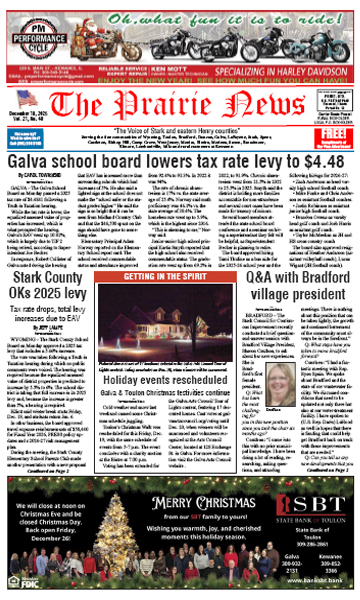Princeville board hears
tax benefits of turbines
By NICK VLAHOS
For The Weekly Post
PRINCEVILLE – A proposed wind-energy project in northwest Peoria County might provide millions of property-tax dollars for the Princeville and Brimfield school districts.
Figures that Four Creeks Wind Manager Carson Robers provided following a Princeville Village Board meeting Monday night indicated local schools are expected to receive almost $108 million in tax revenue over the 40-year life of the project. The projected total for Brimfield schools is almost $34.5 million.
“Our contributions to the school districts are going to be meaningful and are going to set up Princeville and Brimfield schools for the next half-a-century,” Milwaukee-based Robers said.
Schools account for most of the money the proposed project is expected to generate for 20 taxing bodies in its 24,000-acre area. More than 100 landowners in Brimfield, Jubilee, Millbrook and Princeville townships have agreed to wind-turbine leases, Robers told the board.
“We’re going to be making a significant investment in building these turbines, contributing to the property-tax base, creating jobs,” Robers said after the meeting. “Not just during construction but long-term, stable jobs in this part of the county, to keep people here, for people to be able to keep their farms and continue doing what they love and protecting their land.”
Houston-based Repsol USA, the Four Creeks Wind overseer, is expected to ask for Peoria County approval sometime this spring or summer. The process is to include public hearings. Should approval be forthcoming, wind-turbine construction could begin in 2026 and take a year or two, Robers said.
Repsol commissioned the property-tax study Strategic Economic Research of Normal undertook. Townships, library districts and fire-protection districts in the wind-farm area might receive tax revenues ranging from about $75,000 to $7.7 million individually over 40 years.
Unofficially, most Princeville trustees are opposed to area wind-farm projects, according to Village President Jeff Troutman. Last month, the board approved an ordinance that effectively prohibits wind turbines within 1½ miles of Princeville.
None of the projected 80 to 100 turbines is planned for that buffer zone, according to Robers. But he proposed a community-benefits agreement with the village. Repsol might pay the village $20,000 for each of three or four project-development benchmarks, then $10,000 annually, Robers said.
Trustees didn’t comment publicly following Robers’ presentation. In response to a question from Village Public Works Superintendent Chad Gardner, Robers said most of the 400 megawatts of power the project is to generate probably will fuel a large Illinois manufacturer or corporation.
“This energy isn’t going to the City of Chicago,” Robers said.
Later, Robers said the height of the proposed turbines is in the 650-foot range, about the same as a wind project commissioned recently near Kewanee. Previous reports about 700-foot turbines were based on the maximum height the federal government has permitted Four Creeks Wind to build.
Traditional turbines are about 200 feet. Taller ones are common for modern wind-energy projects and indicate advancement of industry technology, according to Robers.
“By having taller turbines, each produces significantly more energy,” he said. “It also means fewer turbines for the same-sized project. It also means they’re much farther from everything. The impacts are very incremental for a higher turbine, but you have much more benefits.”
In other business, the board gave preliminary approval to installing stop signs on Walnut Avenue at Evans Street. Currently, stop signs are only on Evans Street. Visibility issues due to vehicles parked near the intersection prompted the change, Trustee Rick Pope said.
Stop signs cost about $200 each, Gardner said. Final board authorization is expected Jan. 21.







